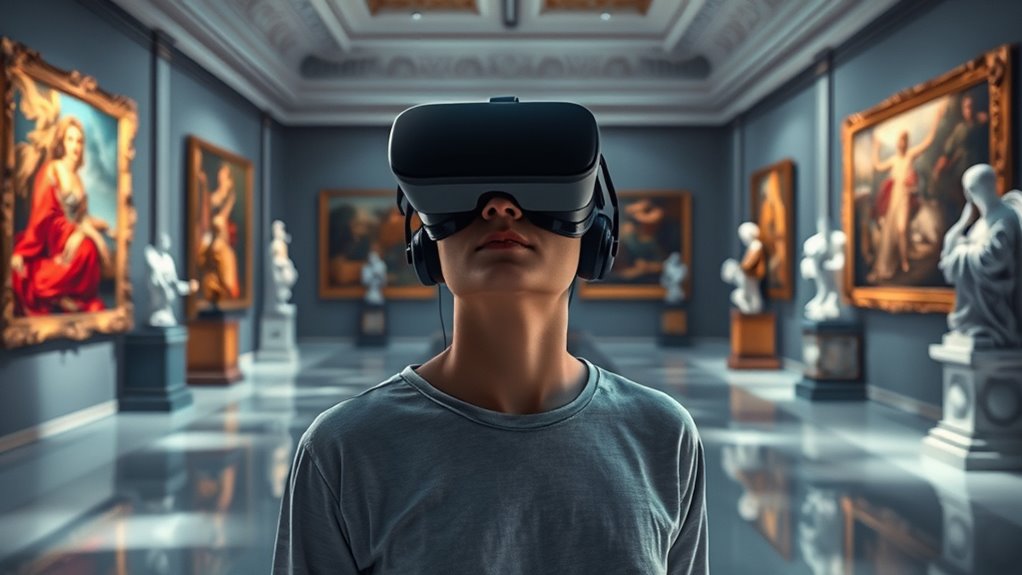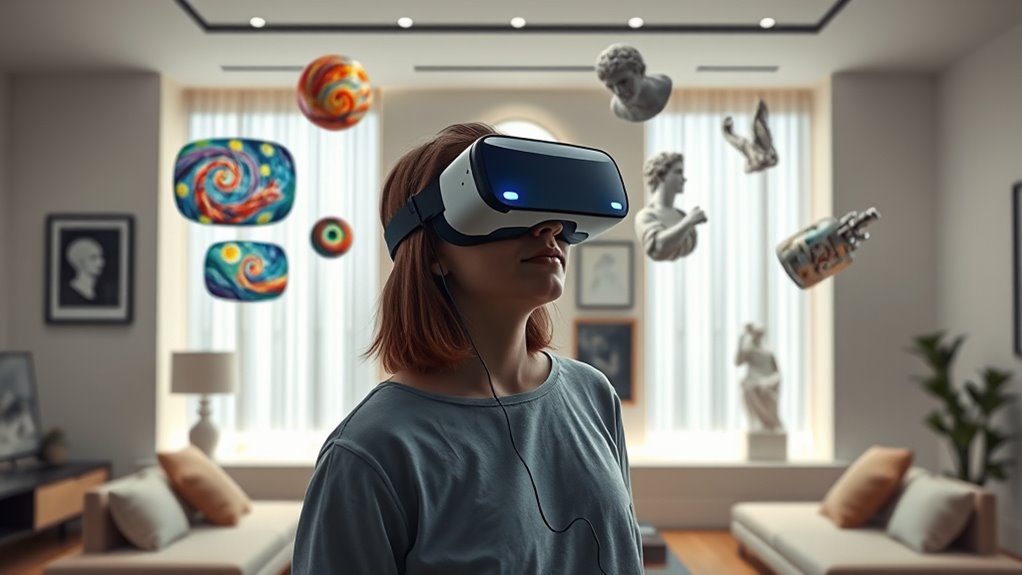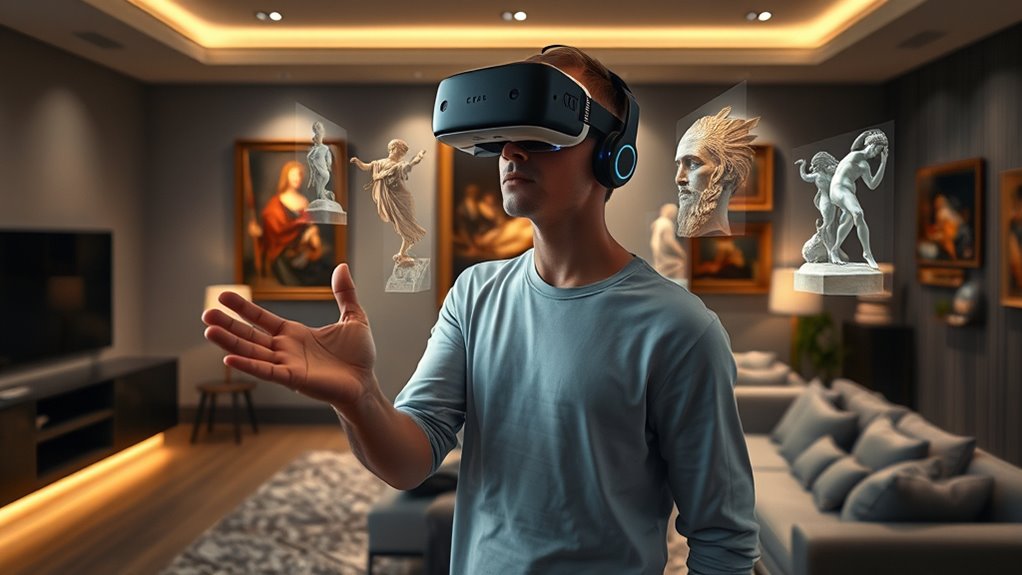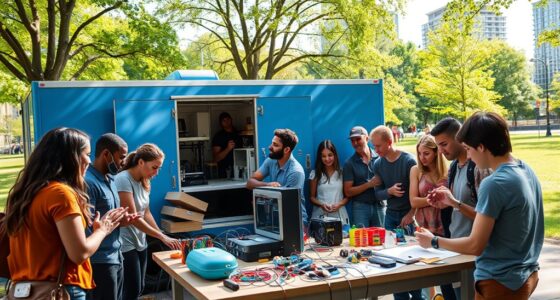Virtual reality museums are transforming how you experience art by making masterpieces accessible right from your living room. You can explore renowned galleries, examine artworks in detail, and even interact with exhibits as if you’re there in person. This technology breaks down geographical barriers and promotes inclusive access for all. If you’re curious about how these immersive environments are changing cultural encounters, keep exploring to discover more about this exciting evolution.
Key Takeaways
- Virtual reality museums enable users to explore renowned artworks from home, breaking geographical barriers and increasing accessibility.
- Immersive VR experiences allow detailed examination of masterpieces, revealing brushstrokes and sculptures up close.
- Users can interact with artworks through active participation, enhancing emotional connection and understanding.
- VR platforms offer virtual tours of major cultural institutions, making art collections accessible worldwide.
- Advanced VR technology promotes inclusive access, ensuring everyone can enjoy and learn from masterpieces regardless of physical ability.
How Virtual Reality Is Changing Art Appreciation

Virtual reality is revolutionizing how you experience and appreciate art by making galleries more accessible and immersive. With augmented exhibitions, you can explore artworks in new dimensions, gaining context and details that traditional viewing might miss. VR enhances immersive storytelling, allowing you to step inside a painting or sculpture, engaging with the art on a personal level. This technology transforms passive observation into active participation, where you can interact with exhibits, uncover hidden layers, and understand the artist’s intent more deeply. Virtual reality breaks down geographical barriers, bringing world-class collections directly to your living room. By blending augmented exhibitions with immersive storytelling, VR creates a dynamic, engaging environment for discovering and connecting with art in ways never before possible. Safe display environments ensure that users can enjoy these immersive experiences comfortably and securely.
Top Virtual Reality Museums Around the World

As technology advances, numerous virtual reality museums around the world offer immersive experiences that rival physical visits. You can explore renowned institutions like The British Museum’s virtual tours, which let you walk through galleries from your living room. The Louvre’s VR experience combines augmented reality, enhancing your view with detailed artwork information and interactive elements. The Smithsonian’s virtual exhibits transport you to historic exhibits without leaving home. These top VR museums leverage cutting-edge technology to make art accessible worldwide. Whether you’re browsing classics or discovering new collections, virtual tours and augmented reality bring a sense of presence and interactivity that makes each visit memorable. These virtual museums truly redefine how you engage with art and history across borders. Additionally, they foster ethical considerations by promoting inclusive access and preserving cultural heritage in innovative ways.
Exploring Iconic Artworks in a Digital Space

Exploring iconic artworks in a digital space allows you to experience masterpieces in ways impossible through traditional viewing. Digital curation enhances this experience by organizing artworks in meaningful contexts, helping you appreciate their history and significance. Virtual reality enables you to examine paintings and sculptures up close, revealing details missed in physical galleries. Immersive storytelling guides you through each piece’s story, techniques, and cultural background, making the art more engaging and memorable. You can navigate through virtual exhibitions, zoom into intricate brushstrokes, or explore the artist’s environment, all from your living room. This combination of digital curation and immersive storytelling transforms passive viewing into an active discovery, deepening your understanding and emotional connection with iconic artworks. Additionally, understanding the financial impact of entertainment industries like WWE and popular music can enrich your appreciation of cultural phenomena and their influence on contemporary art.
The Benefits of Virtual Museum Tours

Virtual museum tours make art and history accessible to everyone, no matter where you are. They offer an interactive experience that engages you more deeply than traditional visits. With these tours, learning becomes more inclusive and engaging for all audiences. Incorporating high-quality sound design enhances the immersive quality of virtual exhibits, making the experience more realistic and emotionally resonant.
Accessibility for All
Virtual museum tours break down geographic and physical barriers, making art and history accessible to everyone. With assistive technology like screen readers, subtitles, and audio descriptions, people with disabilities can fully engage with exhibits. Virtual platforms often incorporate universal design principles, ensuring interfaces are easy to navigate for all users. This approach promotes inclusive design, which enhances the experience for diverse audiences. This inclusivity means that individuals who might face challenges visiting physical museums—due to mobility, sensory, or other limitations—can experience masterpieces from their own homes. By removing physical constraints, virtual tours promote equal access, fostering a richer understanding of culture and history for everyone. These innovations demonstrate that virtual reality isn’t just a technological advance; it’s a powerful tool for creating an inclusive cultural experience.
Interactive Learning Experience
Have you ever wondered how interactive features in virtual museum tours enhance your learning experience? Augmented reality brings artworks to life, allowing you to explore details and context that static images can’t offer. These immersive tools make your visit more engaging and memorable. Gamified learning elements, like quizzes or challenges, motivate you to actively participate and retain information better. Virtual museums often incorporate interactive touchpoints, 3D models, and AR overlays, transforming passive viewing into an engaging adventure. This dynamic approach caters to various learning styles, making complex histories or artistic techniques easier to understand. Additionally, immersive technology allows for a deeper exploration of artworks, providing a richer understanding of the masterpieces. With these features, you’re not just observing; you’re exploring, discovering, and connecting with masterpieces on a deeper level, all from the comfort of your own home.
Technology Behind Virtual Reality Museum Experiences

The technology behind virtual reality museum experiences relies on a combination of advanced hardware and software that work together to create immersive environments. You’ll notice haptic feedback devices that simulate the sensation of touching artifacts, making interactions feel real. 3D modeling plays a vital role by digitally recreating artworks and museum spaces with high precision, allowing you to explore every detail from your living room. Headsets with motion tracking enable you to look around naturally, enhancing immersion. The software integrates these elements seamlessly, rendering realistic visuals and responsive controls. This sophisticated setup guarantees you don’t just see masterpieces—you feel as if you’re standing right in front of them. Overall, these technological innovations make virtual museum visits engaging, interactive, and incredibly lifelike. Incorporating data-driven strategies can further optimize user engagement and personalize the experience for each visitor.
Accessibility and Inclusivity in Digital Art Spaces

Advancements in virtual reality technology are opening new doors for making digital art spaces more accessible and inclusive. By prioritizing digital inclusion, developers ensure that people with diverse abilities can experience art comfortably. Features like adjustable text sizes, audio descriptions, and subtitles help accommodate user diversity, allowing everyone to engage fully. VR platforms are increasingly incorporating accessibility tools such as alternative navigation options and customizable controls, making the experience more user-friendly. This focus on user-centered design helps break down barriers, enabling visitors with disabilities or different backgrounds to explore masterpieces without limitations. As a result, virtual reality museums foster a more equitable environment, inviting a broader audience to appreciate cultural heritage regardless of physical or cognitive differences.
Future Trends in Virtual Reality Cultural Exhibitions

As virtual reality technology continues to evolve, future trends in cultural exhibitions promise to transform how you experience art and history. You’ll see more opportunities for virtual reality socialization, allowing you to explore museums with friends or meet other enthusiasts in shared digital spaces. Immersive storytelling will become even more sophisticated, enabling you to engage with exhibits on a deeper level through interactive narratives and dynamic environments. These advancements will make cultural experiences more personalized and engaging, blurring the lines between observer and participant. Expect virtual tours to incorporate real-time interactions, expert-led discussions, and collaborative exploration. Additionally, the integration of interactive displays will further enhance engagement, making the virtual museum experience more dynamic and memorable. Ultimately, these trends will enhance your ability to connect with art and history, creating more meaningful and accessible cultural encounters from the comfort of your own home.
Frequently Asked Questions
How Do Virtual Reality Museums Ensure the Authenticity of Displayed Artworks?
You might wonder how virtual reality museums ensure artwork authenticity. They rely on digital authentication methods, which verify each piece’s provenance, confirming its origin and history. These systems often include detailed metadata, certificates, and blockchain technology to prevent forgery. By combining these tools, VR museums maintain credibility, allowing you to trust that the displayed artworks are genuine, preserving their value and historical importance in a virtual setting.
Can Virtual Reality Museum Experiences Be Customized for Individual Preferences?
Did you know 85% of users prefer personalized experiences? Virtual reality museums can definitely customize your visit through various personalization options. You get to choose exhibits, set preferences, and explore at your own pace. A user interface design tailored to your needs makes navigation easy and engaging. So, yes, VR museums actively adapt to your interests, creating a unique, immersive experience that feels just right for you.
What Are the Costs Associated With Developing and Accessing VR Museum Platforms?
When considering the costs of VR museum platforms, you should look at development costs, which include creating immersive environments and high-quality visuals. Additionally, user access fees may be charged for entry or premium content. These expenses vary depending on the platform’s complexity and features. By understanding these costs, you can better plan your budget for exploring or developing virtual museum experiences.
How Do Virtual Reality Museums Handle Copyright and Licensing Issues?
You might wonder how VR museums handle copyright and licensing issues. They typically secure digital rights through licensing agreements with artwork owners or institutions, ensuring they have legal permission to display pieces. These agreements clarify usage rights, preventing copyright infringement. By actively managing licensing and adhering to digital rights policies, VR museums protect creators’ rights while offering immersive experiences to visitors.
Will VR Museum Technology Replace Traditional Brick-And-Mortar Institutions?
This question is hotter than the sun! While VR museum tech offers incredible digital preservation and immersive storytelling, it’s unlikely to fully replace traditional brick-and-mortar museums. You still crave the tactile experience and ambiance only physical spaces provide. Instead, VR enhances access and engagement, complementing the real thing. So, expect a future where both coexist, enriching your cultural journey rather than replacing the timeless charm of visiting museums in person.
Conclusion
Virtual reality museums are revolutionizing how you experience art, making masterpieces accessible anytime and anywhere. As the saying goes, “A picture is worth a thousand words,” and now, you can immerse yourself in these artworks firsthand. Embracing this technology not only broadens your cultural horizons but also guarantees art is inclusive for everyone. So, keep an open mind and explore these digital galleries—you might just find that the world’s greatest art is now at your fingertips.










